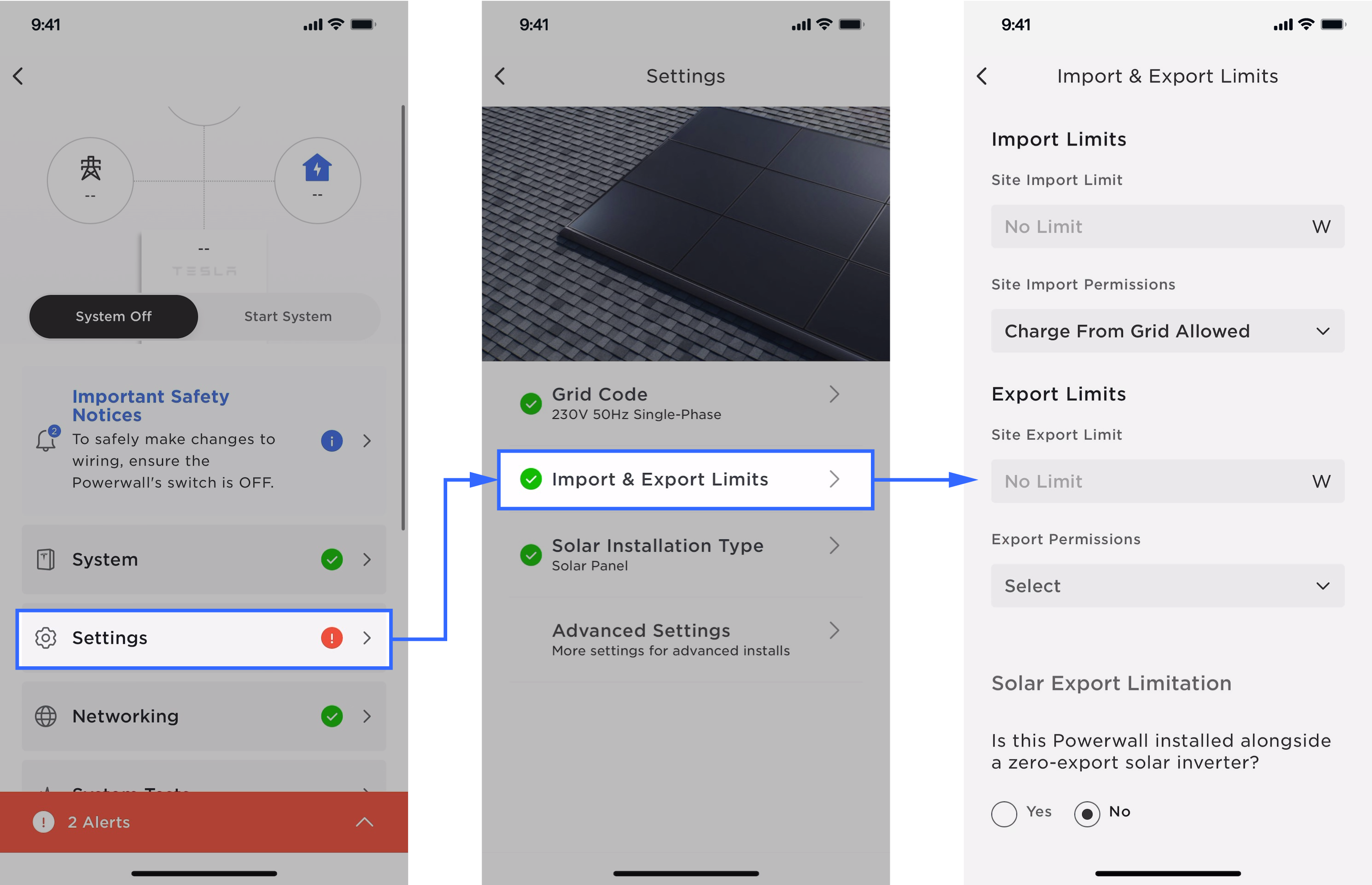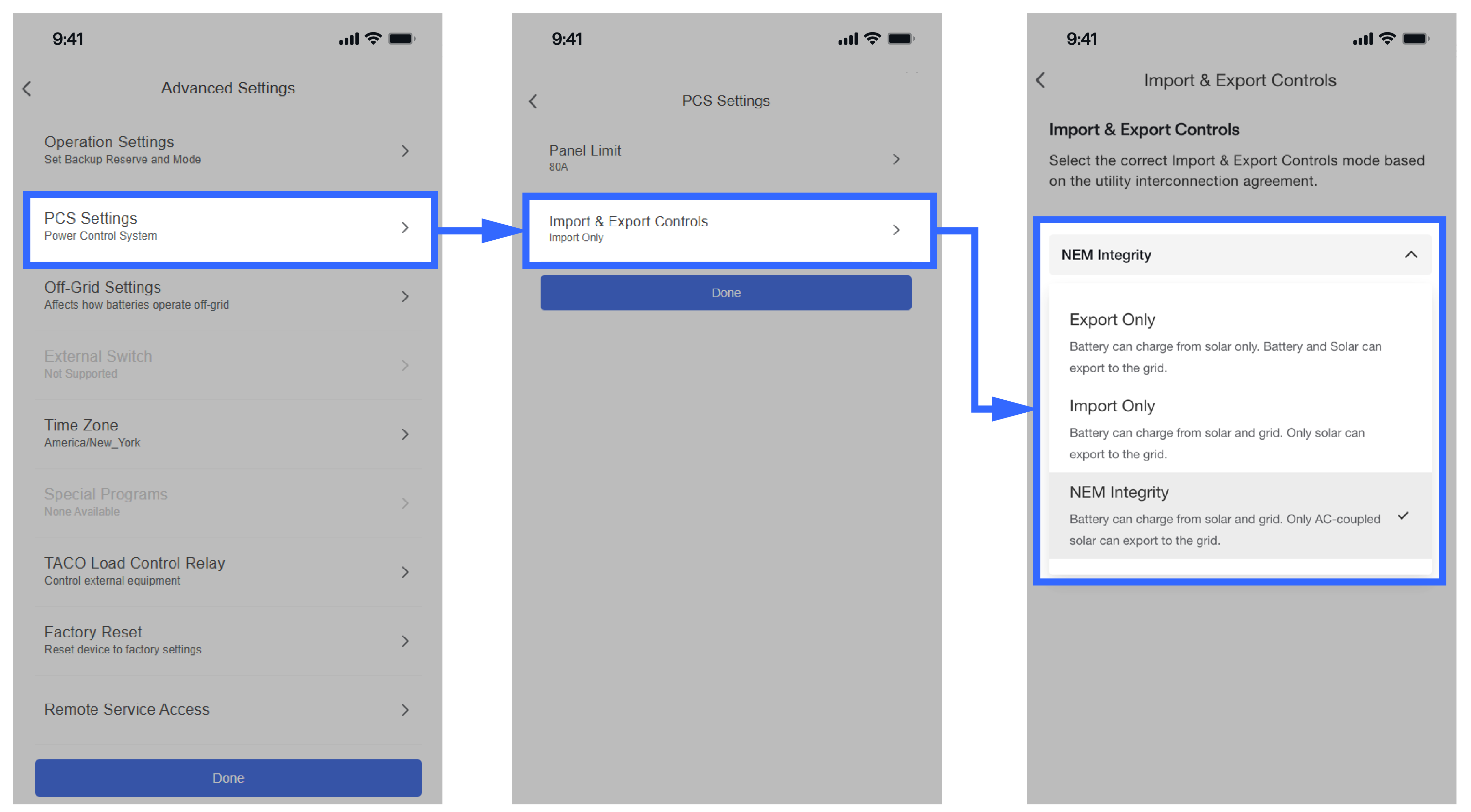Site Limit Feature
Feature Overview
Every system has a Site meter which monitors energy flow to and from the grid. For some systems there may be restrictions on the maximum power that can be sent in one direction or the other; there are a variety of reasons for these restrictions, as described below. The Site Limit feature allows Qualified Personnel to set Site Import and/or Export limits to ensure the system does not exceed the amount of power that can be imported or exported per site requirements. As described below, Site Import and Export limits can be set to restrict import/export by source (e.g. Powerwalls can only charge from Solar) or to limit import/export to a numerical value (e.g. can only export up to 10 kW).
The net site power measurement can be a virtual aggregated meter. For example, when both Gateway Meter X and Meter Y are measuring Site, the combination of Meter X and Meter Y are considered the aggregated Site meter. Therefore, abide by all prior guidance on meters and CTs.
System Import Permissions
System Import Permissions can be set to configure the energy source that Powerwall can charge from (grid and solar or only solar). System Import Permissions only apply to Powerwall systems with solar, as Powerwall systems without solar can only charge from the grid.
The default System Import Permission for Powerwall systems with solar is “Charge from Grid Allowed,” which enables the customer to configure grid charging in their Tesla app (when charging from grid is allowed by the installer, the default setting in the customer app is to not charge from grid unless the customer enables it). The installer may select “Charge from Grid Disallowed” on the Import & Export Limits page in Tesla One which will prevent the customer from configuring grid charging in the Tesla app.
Site Import Limits

There may be a limit on how much power the site is allowed to import (see Application of the Site Import Limits Feature below for examples). In this case a Site Import Limit can be set to comply with that power limit. In the Tesla One Device Setup App, go to to set the Site Import Limit. Depending on the limit set, this may result in Powerwall charging slower or discharging to keep the Site below the limit.

To stay at or below the Site Import Limit, first Powerwall reduces its charge rate. If necessary, it also discharges to the system. If the Site Import Limit is 10 kW and the system is importing 8 kW, Powerwall could charge at a max rate of 2 kW. In the same scenario, if the system is importing 12 kW then Powerwall will discharge at a rate of 2 kW to keep the overall import at 10 kW.
Notes:
- Available for Powerwall systems (with or without solar)
- Rarely used application in North American market
- Not the counterpart of Conductor Limits
- It may result in Powerwall charging at a slower rate, not charging at times of high load demand, or even discharging to keep the Site underneath the set limit
Application of the Site Import Limits Feature
Example 1: Prevent Breaker Tripping
A system has six Powerwalls which charge from the grid at up to 5 kW each, for a total of 30 kW (125A). The system has a 100 A main breaker. To prevent the system from tripping the breaker, the installer limits site import to 80% of the main breaker, or 80 A. The Site Import Limit is set as 19,200 W.
Example 2: Prevent Main Panel or Transformer Upgrade
Some jurisdictions require that Powerwall be calculated as a load. In a system that is already fully loaded, this may result in a main panel and service upgrade. In rare cases, a utility may require a transformer upgrade to accommodate the Powerwall.
A system has 10 Powerwalls which charge from the grid at up to 5 kW each, for a total of 50 kW. The system has a 10 kVA transformer (continuous power rating). To avoid a transformer upgrade, the Site Import Limit is set as 10,000 W.
System Export Permissions
System Export Permissions determine whether Powerwall (the battery) and/or Solar can export to the grid. System Export Permissions are determined by the utility, the permit, and the interconnect agreement – follow the most restrictive of these three for any site.
The installer can select one of the following modes of operation for the system:
- Default (Solar Only): The battery is commanded to not export beyond the site meter. The export at the site meter will be limited to the amount measured by the solar meter. Both controlled and uncontrolled solar will export.
- Permanent Non Export: The battery and solar are commanded to never export beyond the site meter. See Appendix A: Powerwall+ and Powerwall 3 Permanent Non-Export for more information.
- Solar and Battery Export: Both controlled and uncontrolled battery and solar will export beyond the site meter.
-
AC-Coupled Solar Only (NEM Integrity, Powerwall 3 systems only): The battery is commanded
to not export beyond the site meter. The export at the site meter will be limited to the
amount measured by the solar meter. Only uncontrolled AC-coupled solar will export.NoteA Solar meter must be configured to select AC-Coupled Solar Only.NoteSee the Powerwall NEM Integrity Mode Application Note for system configurations compatible with NEM Integrity Mode.
Site Export Limits
For systems that can export to the grid, there may be a limit on how much power the site is allowed to export. In this case a Site Export Limit can be set to comply with that power limit. In the Tesla One Device Setup App, go to to set the Site Export Limit.

To stay at or below the Site Export Limit, Powerwall first reduces discharge, then charges, then solar is curtailed. Below are a few examples for a system with no loads and a 10 kW Site Export Limit:
- If solar production is at 8 kW, Powerwall can discharge at a rate of up to 2 kW to keep the overall export within 10 kW.
- If solar production is at 13 kW, Powerwall will charge at a rate of at least 3 kW to keep the overall export within 10 kW.
- If available solar production is 18 kW, Powerwall will charge at a rate of 5 kW (its maximum), then solar will be curtailed to 15 kW to keep the overall export within 10 kW.
Application of Site Export Limits
Example 1: Utility Interconnect Requirement
The utility allows for up to 10 kW of solar export based on permit type. Rather than install only 10 kW of solar which may result in being unable to power system loads, a Site Export Limit of 10 kW allows for a larger system that adequately powers loads without violating the limit.
For example, if 15 kW of solar are installed, the Site Export Limit ensures that no more than 10 kW are exported at any time.
Example 2: Incentive Limit
A system is incentivized for exporting up to 10 kW of solar. If there is a penalty for exporting more than 10 kW, the Site Export limit can be set to 10 kW. In this instance, if 12 kW of uncontrolled solar is being produced, Powerwall will charge at a rate of 2 kW to prevent the Site Export limit from being exceeded. Any controlled solar (produced by Powerwall+ or Powerwall 3) would be curtailed.
System Import and Export Permissions Where PCS Operating Mode is Required

Reference: Battery Charging and Energy Export Permissions
| PCS Operating Mode | Import Permissions | Export Permissions | Text Description |
|---|---|---|---|
| Import Only | Charge from grid allowed | Solar Only | Battery can charge from solar and grid. Only solar can export to grid. |
| Export Only | Charge from grid disallowed | Battery and Solar | Battery can charge from solar only. Battery and solar can export to the grid. |
| NEM Integrity (Powerwall 3 systems only) | Charge from grid allowed | AC-Coupled Solar Only | Battery can charge from solar and grid. Only AC-coupled (uncontrolled) solar can export to grid. |
| Other Operating Mode | Charge from grid disallowed | Solar Only | Battery can charge from solar only. Only solar can export to grid . |
| Other Operating Mode | Charge from grid disallowed | Permanent non export | Battery can charge from solar only. Zero export to the grid. |
| Other Operating Mode | Charge from grid allowed | Battery and Solar | Battery can charge from solar and grid. Battery and Solar can export to the grid. |
| Other Operating Mode | Charge from grid allowed | Permanent non export | Battery can charge from solar and grid. Zero export to the grid. |